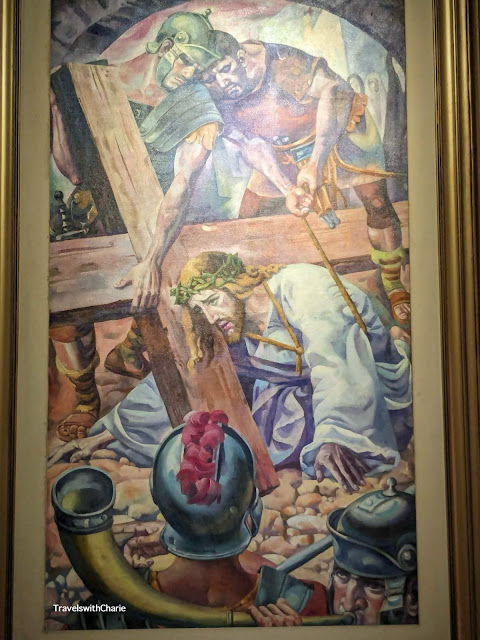Third Station: Jesus falls the first time
1960. Oil on canvas. Don Bosco Chapel Series
It’s been several years since I’ve been trying to see the complete set of paintings of the Stations of the Cross by Carlos “Botong” Francisco but the pandemic got in the way and then in 2023, we were denied entry to the two schools where these stations of the cross are displayed; at FEU University’s Our Lady of Fatima Chapel and Don Bosco Technical College. Both are in Metro Manila. We were denied entry to these chapels because a permit is required for non students to enter school grounds. I did as the staff suggested and sent requests online to view these paintings in March 2024 when I was in the Philippines but neither of them responded affirmatively or at all. I’m saddened by this denial as my intention is simple: to write and inform my readers about the artworks of Francisco. My blogs about his paintings have been viewed by more than 100,000 readers and it’s obvious there’s a profound interest in his works. I’m glad my posts fulfill the public’s need to read and appreciate Francisco's vast body of works. If any of you have ideas or suggestions on how I can see the Stations of the Cross at FEU Chapel or Don Bosco in person, please send me a message. I would really appreciate it.
Detail of the 3rd Station of the Cross
That said, I was pleased to see two paintings of the Stations of the Cross (there are 14 Stations of the Cross) at the National Museum of the Philippines which also displays Filipino Struggles in History and Progress of Medicine in the Philippines, both masterpieces by Francisco. These stations of the cross are unique because Francisco paints Roman soldiers, clearly a delineation from his portrayal of Filipino subjects and themes. In the painting, the soldiers’ facial expressions are intense while Jesus is regal and calm amidst the unfolding drama of his crucifixion. The weight of the cross has brought Him down. But He doesn’t show any pain as his body hits the ground. Everything He’s feeling and thinking are beautifully conveyed in his eyes. Francisco manages to evoke the divinity of Jesus through his facial expression.
You can read about Filipino Struggles in History here: https://www.travelswithcharie.com/2019/05/filipino-struggles-in-history-carlos.html
This is the link to Progress of Medicine in the Philippines: https://www.travelswithcharie.com/2018/07/the-art-of-carlos-botong-francisco.html
Fifth Station: Simone of Cyrene helps Jesus carry his cross
1960. Oil on canvas. Don Bosco Chapel Series
The hands of Jesus are tied with a rope connected to the right hand of a soldier who is perhaps afraid that Jesus will try to escape. We see Simone’s head behind Jesus as he takes on the cross to relieve Jesus momentarily from this heavy burden.
Fragment from 500 Years in Philippine History
1953. Oil on Wood.
It’s amazing to see this fragment of the mural Francisco created for the 1953 International Fair which was held in Manila. There’s not much known about this twelve-panel mural after the fair ended. Only a watercolor on paper study exists of the mural that is now part of the Ayala Museum collection. For more information about 500 Years in Philippine History, follow this link: https://youtu.be/-USTeTYlkg0?feature=shared
Detail of Fragment from 500 Years in Philippine History
The Gallery where the Stations of the Cross are displayed
Entrance to the National Museum of the Philippines is free. For directions, hours and opening times, follow this link: https://www.nationalmuseum.gov.ph/
*****
Images by TravelswithCharie





